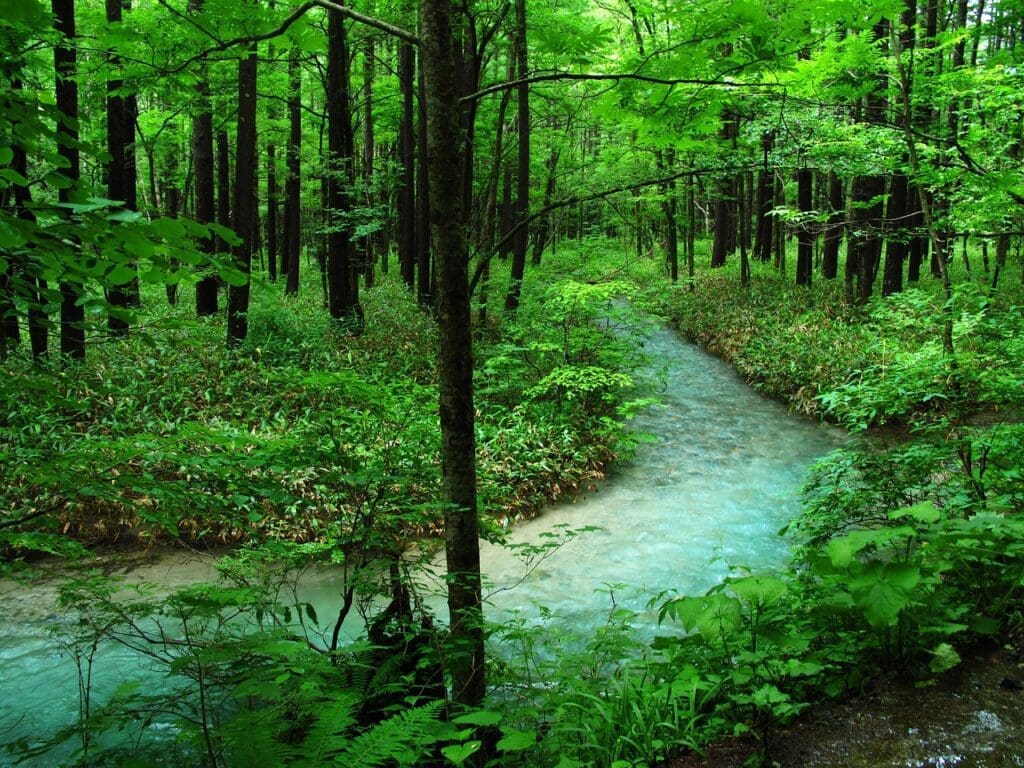Introduction
In our fast-paced, technology-driven world, finding solace and tranquility can be challenging. If you follow, Nirvana essence, we have talked about Nature’s healing effects in a post published earlier. Embrace the tranquility of nature and immerse yourself in the forest, experiencing its healing, revitalizing power. This is the essence of the Japanese practice of forest bathing or ‘Shinrin-yoku,’ which was introduced by the Japanese government in the 1980s.
It’s not just a walk in the woods, but a mindful experience that engages all your senses, a meditative practice that offers significant physiological and psychological benefits. Here at NirvanaEssence, we want to explore this restorative Japanese art, its underlying principles, and its incredible advantages.
What is Forest Bathing?
Forest bathing, or Shinrin-yoku, which directly translates to “taking in the forest atmosphere,” emerged in Japan in the 1980s as a response to rising stress levels and health concerns in the urban population. Unlike forest walking or nature walks that focus on physical exercise or reaching a destination, forest bathing emphasizes slow, immersive interactions with the natural world. Forest bathers are encouraged to breathe deeply, take in the scenery, listen to the rustling leaves, touch the rough bark of trees, and even taste the fresh forest air. The goal is to form a deep, rejuvenating connection with nature, allowing it to cleanse your mind, body, and soul.
Forest Bathing versus Forest Therapy
Forest bathing is often confused with forest therapy. Although they both involve spending time in a forest, the concepts are slightly different. Forest therapy refers to a broad range of professional practices that integrate forest environments for therapeutic interventions. Forest bathing, on the other hand, can be performed alone, focusing on an individual’s immersive, personal experience in nature.
Benefits of Spending Time in Nature
Spending time in nature offers a myriad of health benefits. The effects aren’t just psychological – they’re also physiological. This is something we simply don’t get anywhere else. Being in nature reduces blood pressure, heart rate, and stress hormone production, boosting your mood and energy levels. It enhances the immune system, increases the ability to focus, and even speeds up recovery from illness or surgery.
The Japanese Art of Forest Bathing
The practice of forest bathing was introduced by the Japanese Forestry Agency, promoting it as a natural way to enhance health and wellbeing. Today, the value of forest bathing has become internationally recognized, and people around the world are now embracing this restorative practice.

How Does Forest Bathing Work?
Physiological Effects of Forest Bathing
A number of scientific studies, including a systematic review and meta-analysis, have shed light on the physiological effects of forest bathing. It has been found that forest environments can significantly decrease heart rate and high blood pressure. Nippon Medical School in Tokyo conducted a groundbreaking study led by Qing Li that found that forest environments lead to increased Natural Killer (NK) cell activity. NK cells are a type of white blood cell that helps the body fight off viruses and cancer.
Spending just a few hours of forest bathing can also lower cortisol levels, a primary stress hormone. The effects of forest bathing on the autonomic nervous system activity have been studied extensively, revealing a reduction in sympathetic nerve activity (associated with the ‘fight or flight’ response) and an increase in parasympathetic nerve activity (related to ‘rest and digest’ activities).
Psychological Effects of Forest Bathing
Forest bathing doesn’t just affect your body; it also significantly benefits your mental health. Being in a forest environment reduces anxiety, depression, and anger. The forest atmosphere encourages mindfulness, helping individuals live in the present moment, paying attention to their surroundings and fostering a sense of appreciation for the world around them.
Role of Mindfulness in Forest Bathing
Mindfulness is an integral part of forest bathing. It involves being completely present, fully engaged in whatever is happening at that moment. It means letting your body guide you, following your nose, and paying close attention to your surroundings. In forest bathing, mindfulness helps you deeply connect with nature, enriching your experience and amplifying the benefits to your health and wellbeing.
Understanding the Role of Phytoncides
Phytoncides are natural compounds produced by trees and plants. They have been found to significantly enhance immune function. In fact, the benefits of forest bathing on the immune system, particularly the increased activity of NK cells, are largely attributed to the inhalation of these phytoncides during forest bathing.

What are the Benefits of Forest Bathing?
Scientific Evidence on the Benefits of Forest Bathing
Several scientific studies have revealed the amazing benefits of forest bathing. A systematic review by the Nippon Medical School found that forest environments significantly reduced heart rate and blood pressure in middle-aged and elderly individuals. Another observational pilot study found that forest bathing could be beneficial for elderly patients with chronic heart failure.
Physical Health Benefits of Forest Bathing
Apart from reducing high blood pressure and boosting the immune system, forest bathing has been shown to increase energy levels, improve sleep quality, and enhance overall physical wellbeing.
Psychological Well-being from Forest Bathing
The psychological benefits of forest bathing are equally compelling. It has been found to significantly decrease feelings of stress, anxiety, depression, and hostility, while improving mood, vitality, and life satisfaction.
Boosting the Immune System with Forest Bathing
Studies have shown that just a short forest bathing experience can boost the number and activity of NK cells in our bodies, enhancing our ability to fight off infections and diseases.
Effects of Forest Bathing on Mental Health
Mental health benefits from forest bathing include reduced anxiety and depression, improved mood, increased self-esteem, and improved cognition. Indeed, the psychological benefits of walking in a forest are impressive.

How to Practice Forest Bathing?
Practicing forest bathing is relatively straightforward. Here are some tips to help you get the most out of your forest bathing experience:
- Be sure to leave your phone and camera behind to minimize distractions.
- Take your time. There’s no rush in forest bathing. Allow your body to move at its own pace.
- Use all your senses. Pay attention to what you can see, hear, smell, and touch.
- Don’t just walk. Sit, explore, touch, and let your curiosity guide you.
- Always respect the forest. Don’t disturb the flora and fauna, and ensure you have left no trace of your visit.
Why Forest Bathing Makes Us Feel Good?
Forest bathing makes us feel good because it enables us to reconnect with the natural world, something that is often lost in our fast-paced, urban lifestyles. It allows us to de-stress, to slow down, to breathe, and appreciate our surroundings. The experience can be transformative, helping us gain a fresh perspective on life, boosting our health and happiness.
Conclusion
In our fast-paced world, forest bathing offers a soothing, natural therapy that benefits both our physical and mental health. The Japanese have known the value of this practice since the 1980s, and now the rest of the world is catching up. Try forest bathing for yourself, and feel the transformation it brings.
Related content – 8 Ways to nurture a Deep Connection with the Natural World
Sources –
Forestry England – Forest Bathing
The Association of Nature and Forest Therapy
Dive deeper by following this guide to support your forest bathing journey.
FAQs
What is bathing in the forest?
Bathing in the forest, also known as forest bathing or Shinrin-yoku, is a therapeutic practice that involves immersing oneself in the natural environment of a forest. It is a way to connect with nature, unwind, and experience the healing benefits that forests offer.
What does forest bathing do for your health?
Forest bathing has numerous health benefits. It can reduce stress, anxiety, and depression, boost the immune system, improve mood, enhance cognitive function, and promote overall well-being. Spending time in nature has a profound impact on both our physical and mental health.
What is another name for forest bathing?
Another name for forest bathing is Shinrin-yoku. This term originated in Japan and translates to “forest bathing” or “taking in the forest atmosphere.” It emphasizes the practice of immersing oneself in the natural environment of a forest for therapeutic purposes.
What chemicals are in forest bathing?
Forest bathing involves being surrounded by various chemicals released by trees, known as phytoncides. These volatile organic compounds have antimicrobial properties and are believed to contribute to the health benefits of forest bathing. Phytoncides are responsible for the distinct scent of the forest.
How long should you forest bathe?
The duration of forest bathing can vary depending on individual preferences and availability. Even a short 20-30 minute walk in the forest can yield benefits. However, for a more immersive experience, it is recommended to spend at least 2-3 hours in nature to fully reap the therapeutic effects of forest bathing.
How long do the benefits of forest bathing last?
The benefits of forest bathing can have both immediate and long-lasting effects. Spending time in nature can provide an instant sense of relaxation and rejuvenation. Additionally, research suggests that the positive effects can last for days or even weeks after the forest bathing experience.
What trees are best for forest bathing?
Various types of trees can contribute to the forest bathing experience. Broadleaf trees such as oak, maple, beech, and birch are often preferred due to their rich biodiversity and the pleasant scents they emit. However, any forested area with a mix of tree species can offer the therapeutic benefits of forest bathing.
Does forest bathing involve water?
Forest bathing does not involve literal water bathing. The term “bathing” in forest bathing refers metaphorically to the immersive experience of being surrounded by nature. It emphasizes the practice of fully engaging with the forest environment using all the senses, rather than traditional water-based bathing.
How does forest bathing affect anxiety and depression?
Forest bathing has been shown to have a positive impact on anxiety and depression. The calming and soothing nature of the forest environment, combined with the sensory stimulation it provides, can help reduce anxiety levels and alleviate symptoms of depression. Spending time in nature promotes relaxation and a sense of well-being.
What country is known for forest bathing?
Forest bathing originated in Japan and is deeply rooted in Japanese culture. Japan is particularly known for embracing forest bathing as a way to enhance well-being and reconnect with nature. However, the practice has gained popularity worldwide and can be enjoyed in forests and natural areas around the globe.
Is forest bathing mindfulness?
Forest bathing shares similarities with mindfulness practices, but it is not synonymous with mindfulness. Mindfulness involves being fully present in the moment, observing thoughts and sensations without judgment. Forest bathing incorporates mindfulness elements by encouraging individuals to engage all their senses and be present in the forest environment.
Does forest bathing work in winter?
Yes, forest bathing can be practiced in winter. Although the forest environment may be different during the winter season, it offers its own unique beauty and serenity. The stillness of the winter forest can be surreal.





















